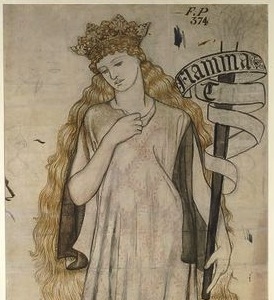“I do not want art for a few, any more than I want education for a few or freedom for a few.”
Perhaps then, William Morris would be pleased to see his designs, including his famous Strawberry Thief, being printed on Dr Martens boots – resonating with his egalitarian ethos.
-
Morris was known for his revolutionary leadership of the Arts and Crafts Movement, which represented the antithesis of rapid industrialisation. It championed nature, romanticism, simplicity and the medieval heritage of Britain.
-
Most remarkably, it elevated craft and design to the realm of art, while simultaneously retaining its democratic spirit.
The Victoria and Albert museum, in particular, continues this legacy by exhibiting pieces of craft and design. Works by Morris bequeathed by his daughter May, under the same roof as examples of what is sometimes called ‘high art’, including studies for John Constable’s Hay Wain.
Additionally, the museum features much-admired nods to pop culture, such as the 2013 exhibition, ‘David Bowie Is’, which was attended by over 42,000 visitors.
This came at the same time as the Department for Culture, Media and Sport’s decision to reclassify craft as a non-creative industry. The department argued that craft is, “more concerned with the manufacturing process”, though it should be noted that the public response to the Classifying and Measuring the Creative Industries consultation has not yet been announced.
The reclassification poses many questions. Is art defined by the medium used, the idea expressed, or the talent of the crafts-person or artist?
Is something truly dreadful, painted on canvas using oil paint, more worthy of being referred to as a work of art than something wonderful made from textiles? If an installation is composed of ceramics, is it craft?
What does this change mean for Turner prize winning Grayson Perry; are his vases and tapestries now to be considered, “more concerned with the manufacturing process?”
What about Morris himself; will his influence be reassessed as craftsmanship and not artistry, despite his many works of art? And will craft itself be considered a term that implies a lack of talent or genius? Or, are these questions all sadly answered by the age old trope that it is not art until someone important says it is?
While these proposed changes seek to diminish the status of the crafts-person, one wonders why music does not face problems such as these. Music is music; no-one dares to suggest that a piece which is written for cellos and harps has less merit than a piece of music written for electric guitars.
There is no Act due to be passed which says Vivaldi is to be revered as an artist and Marc Bolan is to be demoted to a mere performer.
If it was, Nigel Kennedy’s enviably talented antics at the 2013 ‘Last Night of the Proms’ could be considered unmusical despite the fact he was playing the fiendishly complicated Hungarian gypsy dance, Csárdás – that is, when he was not playing the theme tune to Bonanza.
It should be of genuine concern to art audiences how art is defined. Elevating art to loftier heights could lead to it becoming less accessible to the public.
The title of artist may be more difficult to attain.
The practice of viewing, understanding and creating art could be confined to the elite more than it ever has been. Most worryingly of all, art may come to lose its passion, its ability to bridge gaps, its inventiveness and therefore its beauty.











